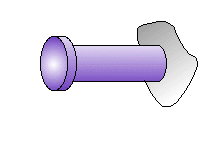In earlier chapters, formulas were developed to obtain the stresses in axial members (bars), torsional members (shafts), pressure vessels, and beams. Each type of component was subjected to one type of load, which caused one type of stress at a material point, e.g., torque causes shear stress.
In general, engineering systems are simultaneously loaded by axial forces, torques, bending moments and shear forces - combined loading - as illustrated in the image below.
|
Click on links to show examples. |

|
Axial forces and bending moments cause normal stresses (axial stress and bending stresses). Torques and shear forces cause shear stresses (due to torsion and shear). When two or more types of loads contribute to the stresses at a cross-section, determining the stress state at any point on the cross-section may seem like a daunting task. However, by breaking the problem down into two or more basic problems, and then superimposing the results of the basic problems, the overall solution can be found. |
|